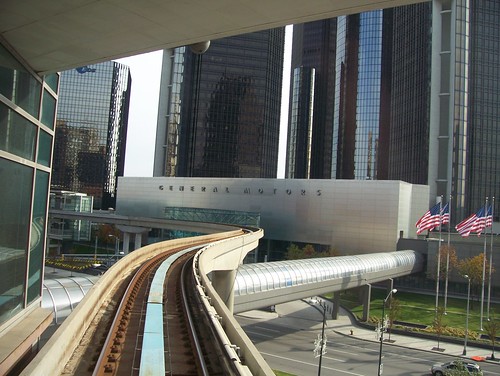
Each week we will be focusing on blogs from around the world dealing specifically with urban environments. We’ll be on the lookout for websites outside the country that approach themes related to urban experiences and issues in Toronto.
– – – – – – – – – – – – – – – – – – – – – – –
From bikes to expressways and pedestrianized rivers, it only makes sense that today’s topic for World Wide Wednesday is public transit. So where better to look to than…Detroit?
Like Toronto and many other cities across the continent, America’s Motor City is moving towards getting a light rail transit system of its own. However, unlike Toronto’s Transit City plan which calls for 124km of new, publicly funded LRT lines in the city, Detroit’s light-rail commuter loop clocks in at a total of 3.4 miles, with the $125 million price tag being covered entirely by the private sector.
Before discounting Detroit’s most recent foray into the world of LRT infrastructure as one not worth serious examination — especially when plenty of other North American cities offer up bigger models — let’s not forget that it’s not the city’s first try (aside from the hardly used People Mover), but a return to days long gone.
The proposed site for the light rail line along Woodward Avenue was actually the route of Detroit’s last streetcar, which was removed in 1956 only to be replaced by diesel buses. That ended 93 years of streetcar service that at one point was operating over 2,800 vehicles.
Detroit transit hit its peak annual ridership of 492 million rides in 1945. Sixty-five years later, that number is now reduced to less than one hundred million. In this context, Detroit’s renewed interest in rail-based public transportation follows a nationwide trend that is emblematic of what one American blogger has called ‘America’s Streetcar Renaissance.’
Yet Detroit poses an interesting case study in this supposed renaissance: first, what role, if any, should the private sector play in funding public transit? Is Detroit’s Woodward Loop symbolic of how the economic benefits of public transit infrastructure are being more widely recognized by the private sector? Do the positives regarding jump-starting Detroit’s stalled transit system with private money outweigh the drawbacks of building a public transit system where private interests and initiatives largely determine routes and service?
To get an idea of the debate surrounding Detroit’s proposed light rail line, check out these blogs:
• The Infrastructurist: America Under Construction
• The Transport Politic
• Faded Detroit
For some interesting articles on Detroit’s LRT plans, see:
• Crain’s Detroit Business
• Light Rail Now!
• The Detroit News
For a more general history of transit in Detroit, here are some good sites:
• Detroit Transit History
• Transportation Riders United
Photo by Wigwam Jones


3 comments
Some information on General Motors’ role in the continent-wide phasing out of streetcar service:
http://en.wikipedia.org/wiki/Great_American_streetcar_scandal
As for private funding for transit: this makes for interesting reading about how streetcars developed in the U.S. — and how they went bust, too: http://www.nap.edu/openbook.php?record_id=10110&page=13
They also explore many of the reasons why European cities and even Canadian ones with sprawl similar to the U.S., have on average higher transit ridership… from government funding in the U.S. applying only to new houses and massive federal money for freeways compared to a slower pace in Canada and Europe, even maximum parking spaces per square foot (Canada, Europe) compared to minimum, not maximum (U.S.)
Long, but very good.
The railways in the UK were privatised in the 1990s and the London Underground, one of the oldest underground rail systems in the world, has undergone various attempts to bring private investment in. I don’t think I’d be alone in saying that neither has worked very well. London Underground is almost entirely publicly owned now (as far as I’m aware) and even parts of the National railways have been brought back into public ownership after years of under-investment (some under public ownership and some under private) have left us with what was until recently a complete disaster of a rail network. It’s now starting to run reasonably efficiently in terms of the number of services and punctuality of those services but it is far and away the most expensive rail service in Europe, indeed in some cases it’s cheaper to fly within the UK than to get the train, consider how small a country we are and you start to get the picture. Our rail system is very widely used, but it’s extortionately expensive and our roads are still congested.
I’m not saying all the problems our public transport face are because of privatisation or private investment, but both were seen as a solution to all our problems for a long time and neither has been successful by any measure.
Perhaps it’s worth looking at how this kind of private investment has fared elsewhere in the world and comparing it to what’s happening in Detroit?